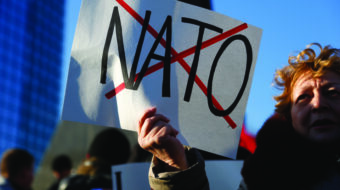After the end of World War II, the U.S.A. and the U.S.S.R., former allies in the fight against fascism, confronted each other as opponents in a “Cold War.” The world was seen to be more and more splitting into two rival camps. Berlin and Germany were divided into “East” and “West.” The United States’ use of nuclear weapons against Japan ignited the atomic age and began an “arms race” with the Soviet Union.
The apocalyptic power of nuclear weapons precluded their use in a “hot” war. Instead, the Cold War was fought mainly through espionage, proxies, and propaganda. McCarthyism infused American culture with conformity and paranoia. Reds were under every bed and rightwing politicians like Richard Nixon made careers of making a show of smoking them out. Nuclear war with Russia seemed imminent as personal bomb shelters became the rage and “duck and cover” became the catchphrase in schools.
For some filmmakers, the Cold War became a convenient excuse for moronic plotlines, insufferable jingoism, and unapologetically reactionary politics. The U.S. government, typically through the military, produced its own propaganda shockers (“Red Nightmare”). Low-budget “exploitation” filmmakers sought to cash in on the zeitgeist with efforts such as “Rocket Attack U.S.A.,” “Beast of Yucca Flats,” and “Red Zone Cuba.” In the eighties, fear of Reagan’s “Evil Empire” inspired American and British movie studios to churn out bigger budgeted (but just as schlocky) Cold War actioners like “The Final Option” and “Red Dawn.”
For those nostalgic for the bad old days of Cold War angst, add these cheesy classics to your holiday viewing queue:
Rocket Attack U.S.A. (1961, Barry Mahon, Dir.)
An American spy (John McCay) parachutes behind the Iron Curtain to uncover Soviet rocket secrets and save the world. He gains access to the Soviet rocket program by playing wing-man to a bloated, hard-partying, Khruschev-esque General, who he hooks up with an accommodating (if lethargic) female double agent (Monica Davis). The Yank spy unsuccessfully storms a missile silo with the help of barely-accented British spy Phillip St. George. Mutual Assured Destruction is triggered, and the world ends in a hail of stock footage.
Red Nightmare (1962, George Waggner, Dir.)
Jack “Joe Friday” Webb narrates as the Reds take over Main Street U.S.A. in this short produced by the U.S. Army. An average American dad (Jack Kelly) watches in horror as his daughter happily goose-steps off with the Red Guard and his hardware store is collectivized. The Commies are about to send him to a re-education camp, but whew! It’s only a dream. Or is it?
Beast of Yucca Flats (1961, Coleman Francis, Dir.)
Pro Wrestler and Ed Wood Jr. regular Tor Johnson plays Russian atom scientist Joseph Javorsky, who defects to the West (Nevada, to be precise) and is pursued across the desert by KGB agents. Just when the agents are about to liquidate the lumbering scientist, they all stumble into an atomic test site, a bomb goes off, and the released radiation turns Tor into some sort of badly scarred homicidal mutant. The enraged “monster” kills everyone he randomly encounters. “The beast” is eventually conquered, and in the film’s final poignant shot a wandering bunny rabbit sniffs his prone corpse. Low budget auteur Coleman Francis’s bizarre direction (endless shots that pan across dirt and focus on pretty much anything other than the story’s action) and non-sequitur narration (“a man runs. Somebody shoots him,”) give this film an art house feel.
Red Zone Cuba (aka Night Train to Mundo Fine, 1966, Coleman Francis, Dir.)
Coleman Francis returns, this time starring as well as producing, directing, etc.
Francis plays escaped con Griffin, who, desperate for a few bucks, signs up to join the Bay of Pigs invasion. This fever dream of a film features endless takes, stilted dialogue, and nonsensical voice-overs. Of course the invasion ends in debacle, and the film ends with another touching Coleman Francis signature death scene: “Griffin ran all the way to hell… with a penny, and a broken cigarette.”
The Final Option (aka Who Dares Wins, 1982, Ian Sharp, Dir.)
According to this movie, the anti-nukes movement was entirely funded and directed by the Soviet Union. In it, Soviet-sponsored terrorists, “The People’s Lobby,” demand a nuclear freeze and take American dignitaries hostage. Peter Skellen (Lewis Collins) is the catatonically suave undercover Special Air Service (SAS) agent who infiltrates the group and seduces its leader (a young Judy Davis in a mortifying early role). The film’s final act is essentially a commercial for the British SAS, which efficiently massacres the bloodthirsty peaceniks and rescues Europe from the scourge of nuclear disarmament.
Red Dawn (1984, John Milius, Dir.)
When the U.S.S.R. and Cuba team up to invade Colorado, Patrick Swayze and his teen commandos (eighties icons C. Thomas Howell, Charlie Sheen, Jennifer Grey and Lea Thompson) form the Wolverines to fight back. This film was recently remade by Dan Bradley, but is currently stuck in distribution limbo. The bad guys in the Red Dawn reboot were originally portrayed as “Red” Chinese. But in an effort to not alienate the burgeoning China film market, the flags, logos, etc. of the invading force in the movie were digitally altered to be those of North Korea. The original Red Dawn’s director, John Milius, has recalibrated his rightwing paranoia to keep up with the times: he recently commented that he thought the new film’s villains should be “illegal aliens.”












Comments